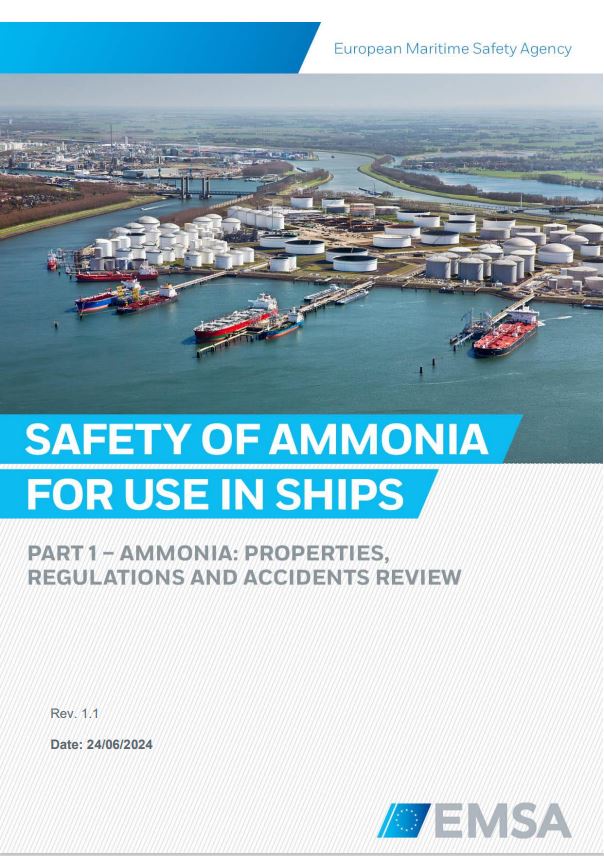 Task 1 of this study presents an extensive analysis of ammonia properties and characteristics and how these are applicable as marine fuel. The main hazard of ammonia in comparison to other conventional and alternatives fuels is toxicity (can start being an occupational hazard from low concentrations (20 ppm for 8 hours exposure - 50 ppm for 15 min exposure) and become a threat for life when in higher concentrations (300 ppm for 30 min exposure - Immediately Dangerous to Life or Health)), and corrosivity. This study provides an analysis of the toxicity and exposure limits of ammonia comparing several regulatory frameworks. Aside from toxicity, the general behaviour of ammonia was investigated, how this reacts with air and water and how that affects other materials with its corrosive nature and through the stress corrosion cracking. Task 1 of this study presents an extensive analysis of ammonia properties and characteristics and how these are applicable as marine fuel. The main hazard of ammonia in comparison to other conventional and alternatives fuels is toxicity (can start being an occupational hazard from low concentrations (20 ppm for 8 hours exposure - 50 ppm for 15 min exposure) and become a threat for life when in higher concentrations (300 ppm for 30 min exposure - Immediately Dangerous to Life or Health)), and corrosivity. This study provides an analysis of the toxicity and exposure limits of ammonia comparing several regulatory frameworks. Aside from toxicity, the general behaviour of ammonia was investigated, how this reacts with air and water and how that affects other materials with its corrosive nature and through the stress corrosion cracking.
This report includes a review of the current onshore and offshore regulatory framework related to the use and transport of ammonia and acknowledges that there is still work to do to address properly the safety hazards of ammonia as fuel.
|
 Task 2 includes the identification of critical equipment and failure modes and a qualitative evaluation of the reliability of ammonia systems. In depth fault tree analysis was conducted through interviews with Subject Matter Experts (SME) in naval architecture, ammonia fuel, engine makers and bunkering equipment vendors. Several reliability models were constructed based on information from LPG application modified to consider ammonia fuel applications. Task 2 includes the identification of critical equipment and failure modes and a qualitative evaluation of the reliability of ammonia systems. In depth fault tree analysis was conducted through interviews with Subject Matter Experts (SME) in naval architecture, ammonia fuel, engine makers and bunkering equipment vendors. Several reliability models were constructed based on information from LPG application modified to consider ammonia fuel applications.
|
 Task 3 describes the results of an hazard and operability study of a generic ammonia fuel supply system from the fuel tank to the internal combustion engine complemented by consequence modelling of potential ammonia leaks through CFD simulation. Task 3 describes the results of an hazard and operability study of a generic ammonia fuel supply system from the fuel tank to the internal combustion engine complemented by consequence modelling of potential ammonia leaks through CFD simulation.
|
|
  Task 4 and Task 5 describe the results of similar HAZID exercises upon the use of ammonia as fuel in specific ship designs - a Newcastlemax dry bulk carrier and a mega ro-ro, respectively - including the risk assessment of scenarios when there are simultaneous operations in ports. Task 4 and Task 5 describe the results of similar HAZID exercises upon the use of ammonia as fuel in specific ship designs - a Newcastlemax dry bulk carrier and a mega ro-ro, respectively - including the risk assessment of scenarios when there are simultaneous operations in ports.
|
The reports made available in this section, developed concurrently with the now-approved IMO Guidelines on the Safe Use of Ammonia as Marine Fuel (MSC.1/Circ.1687), underscored the necessity of a more profound mutual understanding regarding the system’s boundaries and requirements for the safe integration of systems across diverse technology providers. This groundbreaking work offers a valuable reference for stakeholders engaged in addressing this crucial challenge.





